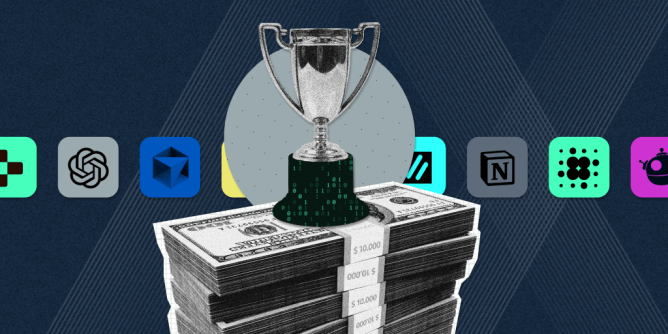By Ed Jennings, CEO of Quickbase
We’re using AI to help our clients solve complex business problems. Here’s where we’re headed next.
At a recent conference, I saw something that rocked my world. A presenter showed the audience brain scans from an MRI that he’d fed into an AI engine, which reported back: “This person is thinking of a boat.” The AI was right: the person had indeed been daydreaming about a boat.
AI-interpreted brain scans might not be an everyday occurrence. But that example crystallized how I am thinking about generative AI, encapsulated in one word: augmented.
Look at Meta’s recent smart glasses collaboration with Ray-Ban. The wearer can walk around a downtown area and, thanks to an arrow visualized on the inside of the lens, can follow directions leading to a hot new restaurant or cool museum show. A mixed-reality experience, blending location-based GPS with local maps, all augmented by AI.
Seems futuristic, right? But it is just the continuation of the type of augmented experiences many of us already enjoy in our cars, where AI monitors traffic to ensure you don’t change lanes at the wrong time. Or in our email, auto-correcting typos and suggesting appropriate responses based on context and prior messages. And on our phones, generating pre-built, structured travel itineraries combining individual confirmation codes into one seamless document for easy access as you navigate airports, cities, and highways in a new country.
Those are just the tip of the iceberg, a few of the potentially billions of applications for AI-driven augmentation in our daily lives – delivering answers that help solve problems.
In my role as CEO at Quickbase, the dynamic work management company, I am engaged constantly in conversation around practical applications of artificial intelligence into the ways we all collaborate and work. It’s exciting to discover new applications of opportunities for AI, making our work lives better and more productive in futuristic and pragmatic ways. These next breakthroughs with AI will happen as our daily and work lives are seamlessly augmented by this powerful technology, all in the service of making work smarter and more efficient, leading to better outcomes.
AI-augmented productivity
At Quickbase, we’ve seen myriad ways that AI boosts productivity. Many of our customers use our product to run extremely large and complex projects – building construction, large-scale manufacturing, global supply chains and the like. Our AI augmentation is applied across a variety of use cases, such as improving intake by auto-generating apps for new projects, identifying potential delays across project portfolios, and efficiently managing project documents and thus enhancing data integrity. Increasing productivity, meeting customer and market demand, and driving revenue.
Looking across these projects helped us spot a common pain point for many of our customers: Gray Work. That’s what we call the time and resources lost when work is done using ad-hoc solutions and workarounds when your technology doesn’t work for you. Valuable data and information as well as best practices and efficiencies wind up trapped in emails, spreadsheets, and other disconnected systems, making it harder to collaborate. Gray Work is a productivity killer, slowing down projects and wasting valuable resources, preventing organizations and employees from getting their work done. AI augmentation is a huge help here, working in the background to make quality improvements to many of these time- and resource-intensive routine tasks.
Say you want to predict equipment maintenance or replacement needs to minimize downtime and costs. Or find under- or over-utilized resources by analyzing market trends and project pipelines to forecast resource demands. Or identify patterns of employee utilization to pinpoint training/skilling needs and balance the ebbs and flows of talent management, recruiting and retention. All of these are real use cases from our customers, and each benefits massively from AI augmentation, connecting disparate data sources to spot trends and patterns as clues, boosting productivity using the power of technology and AI to solve problems quickly to get work done.
Here’s another example: Let’s say you run a solar panel company and want to track inventory, manage installations, and track sales reps. With AI’s help, like what we use in our Quickbase platform, that is super simple. You can type that command into Quickbase AI, and it creates an app to do exactly that, with the ability to modify the app to exactly what you want it to be, presenting the data in the way you like to see it. Think of it like ChatGPT, where the power of AI delivers answers to your questions and solutions (in the form of apps) in just minutes.
Augmentation, Not Replacement
It’s also important to talk about what won’t change. AI won’t replace creative, specialized, or labor-intensive mechanical work. Or the knowledge work that adds true value to the business. Instead, by automating the type of time- and resource-intensive tasks inherent in every project, workers – frontline employees, managers, even developers – are free to focus on meaningful tasks that accelerate productivity and make sure work gets done.
So, in our solar panel example, installation will still be done by technicians in the field. AI will not do that for anyone. But artificial intelligence tools can handle administrative tasks like scheduling deliveries, sending alerts about shipment delays, allocating the right resources to get the panels installed, and making sure there is a backup process in place if something goes awry.
As a leader, I know how crucial it is to have productivity at the forefront of all you do. Yet too often we see the application of AI here start small, and then stay small. I encourage you to go bigger. Fundamentally rethink how AI can reduce or eliminate the Gray Work bogging down your projects and deliverables, and how it can free up your teams to interact with customers, and your leadership to make business decisions. Exploring these fundamental strategic choices can turn ideas that seemed unrealistic or too complex into real possibilities to transform your business.
In my conversations with other leaders about AI, I am seeing a shift away from, “Oh, this is neat… maybe we should play with this” towards, “Oh, this is cool, and it has an immediate application to my business.” AI-powered tools can be a powerful aid, using the capabilities of the entire internet as its brain, augmenting worker productivity by helping employees get out of the Gray Work cycle and focus on actual tasks that matter. We can elevate our ability to focus on the most valuable parts of work, giving rise to endless possibilities. AI, working to make your work better.




